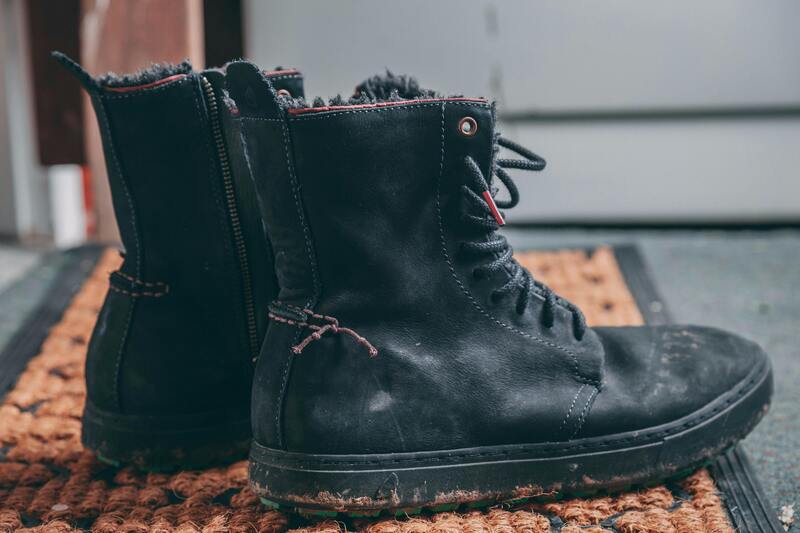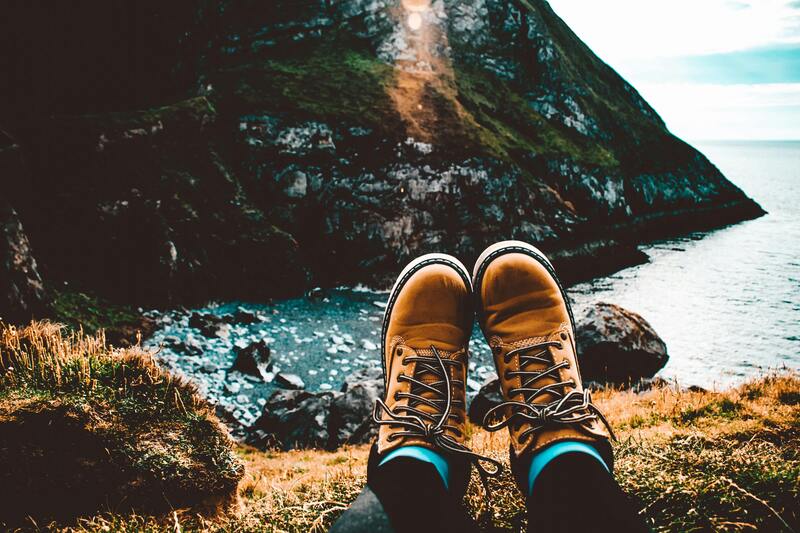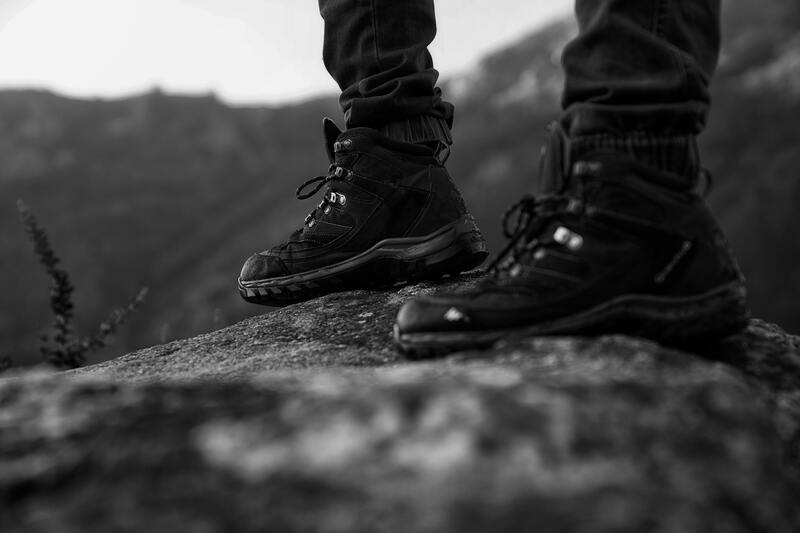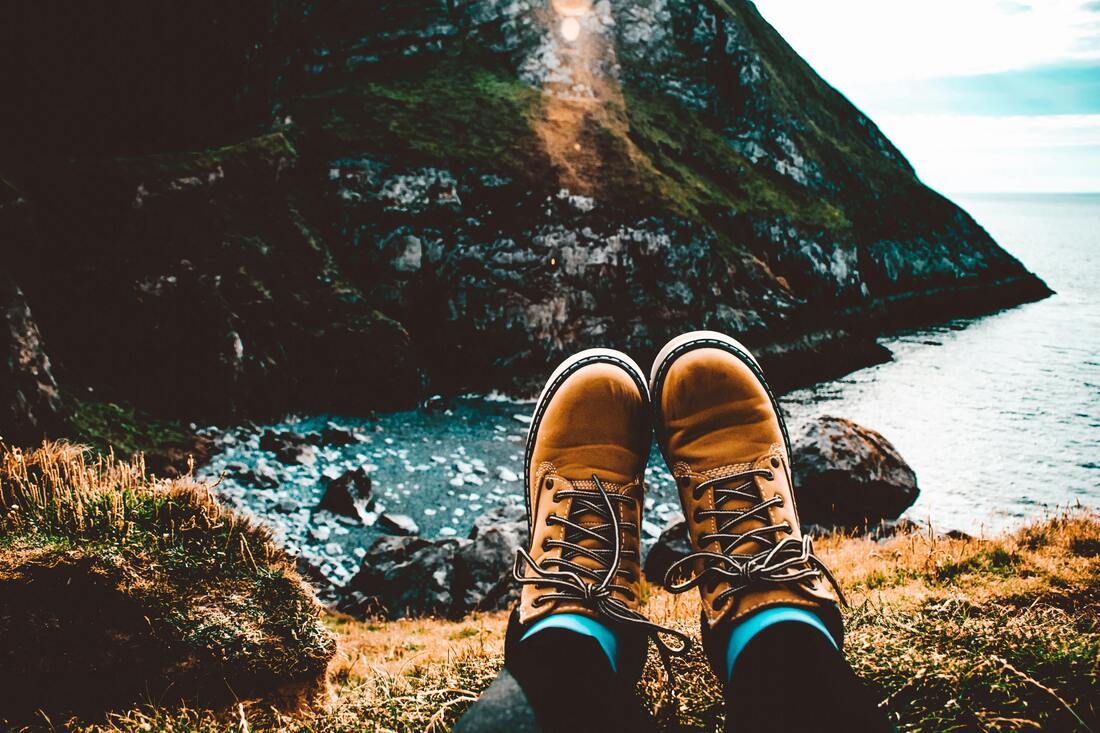For Hiking Footwear:
Low-cut shoes are light and airy, great for easy day hikes on smooth paths.
Mid-cut boots give you some ankle support and work okay on different ground.
High-cut boots really support your ankles, so they're good if you're lugging heavy stuff over rough land.
🧱 What They're Made Of
Upper Part: Leather is tough and keeps water out, but nylon is lighter and lets your feet breathe.
Mid-Layer: EVA foam is soft and light, while polyurethane lasts and helps support heavy weight.
Outer Bottom: Rubber with deep treads grips the ground. A good heel helps when going downhill.
Waterproof Stuff: Things like Gore-Tex keep water out but can make your feet sweat.
🧭 How to Select Best Footwear
Ground Type: Pick stiffer boots with ankle support for rocky, bumpy trails.
Weight in Your Pack: If you're carrying lots, get boots with strong midsoles and outsoles.
Weather: Go for breathable stuff when it's hot and insulated boots when it's cold.
How They Feel: Make sure there's a bit of room (about 1 cm) in front of your longest toe. The boot should fit your foot, snug around the middle and heel.
🧪 Special Things Some Have
Crampon-Ready: Need these for climbing mountains or walking on ice.
Warm Stuff Inside: For extra warmth when it's freezing.
No Animal Stuff: Made without any animal products.
🛠️ Keeping Them Nice
Cleaning: Scrub off mud with a brush and some gentle soap.
How to properly Dry: Don't use a heater; stuff them with paper to keep their shape.
Water Protection: Use the right sprays or creams, like the maker suggests.
🧠 Pro Advice
How They Fit is Most Important: A comfy boot is better than any brand.
Wearing Them In: Wear new boots a bit at a time, so you don't get blisters.
Try Them On Later: Your feet get bigger later in the day, so shop in the afternoon or evening.
Low-cut shoes are light and airy, great for easy day hikes on smooth paths.
Mid-cut boots give you some ankle support and work okay on different ground.
High-cut boots really support your ankles, so they're good if you're lugging heavy stuff over rough land.
🧱 What They're Made Of
Upper Part: Leather is tough and keeps water out, but nylon is lighter and lets your feet breathe.
Mid-Layer: EVA foam is soft and light, while polyurethane lasts and helps support heavy weight.
Outer Bottom: Rubber with deep treads grips the ground. A good heel helps when going downhill.
Waterproof Stuff: Things like Gore-Tex keep water out but can make your feet sweat.
🧭 How to Select Best Footwear
Ground Type: Pick stiffer boots with ankle support for rocky, bumpy trails.
Weight in Your Pack: If you're carrying lots, get boots with strong midsoles and outsoles.
Weather: Go for breathable stuff when it's hot and insulated boots when it's cold.
How They Feel: Make sure there's a bit of room (about 1 cm) in front of your longest toe. The boot should fit your foot, snug around the middle and heel.
🧪 Special Things Some Have
Crampon-Ready: Need these for climbing mountains or walking on ice.
Warm Stuff Inside: For extra warmth when it's freezing.
No Animal Stuff: Made without any animal products.
🛠️ Keeping Them Nice
Cleaning: Scrub off mud with a brush and some gentle soap.
How to properly Dry: Don't use a heater; stuff them with paper to keep their shape.
Water Protection: Use the right sprays or creams, like the maker suggests.
🧠 Pro Advice
How They Fit is Most Important: A comfy boot is better than any brand.
Wearing Them In: Wear new boots a bit at a time, so you don't get blisters.
Try Them On Later: Your feet get bigger later in the day, so shop in the afternoon or evening.
🥾 Hiking Boot Types
1. Hiking Shoes (Low-Cut)
Great For: Easy day hikes on trails that are in good shape.
Good Stuff: They don't weigh much, let your feet breathe, and bend easily.
Heads Up: Not much ankle support, so not your best bet where the trails are rough.
2. Mid-Cut Boots
Great For: Trails that range from medium to hard.
Good Stuff: A good mix of bendiness and ankle support.
Heads Up: If you're carrying a super heavy pack, they might not give you all the support you need.
3. High-Cut Boots
Great For: Backpacking with a heavy load or hiking over hard ground.
Good Stuff: Your ankles will thank you for the support and steadiness.
Heads Up: They're heavier and don't breathe as well. You'll need to wear them a bit before taking them out on the trail.
🧱 What Hiking Boots Are Made Of
Upper Part:
What It's Made Of:
Real Leather: Lasts a long time and keeps water out. Great for rough areas.
Nubuck Leather: A sweet spot between being tough and bendy.
Man-Made Stuff (Like Nylon or Polyester): Light and lets air in, good for short day hikes.
Mid-Part:
What It's Made Of:
EVA (Ethylene Vinyl Acetate): Doesn't weigh much and feels good on your feet.
Polyurethane: Sturdy and can hold up when you're carrying heavy things.
Bottom Part:
What to Look For:
Rubber: Gives you grip and lasts a while.
Lug Pattern: Big bumps that help you grip the ground.
Heel thingy: Keeps you from sliding when you're going downhill.
Keeping Water Out
Your Choices:
Fancy Linings (Like GORE-TEX): Keep water out but still let your feet breathe.
Water-Resistant Coating: Makes water roll off, but you'll need to put it on again sometimes.
🧭 How to Pick the Right Hiking Boot
Think About the Trail
Rocky or Tricky Trails: Go for boots with hard midsoles and tough bottoms.
Muddy or Snowy trails: Get boots with deep lugs and waterproof stuff.
Hot Weather: Light boots that let your feet breathe work best.
Match the Boot to What You're Doing
Day Hikes: Low to mid-cut boots are fine.
Backpacking: High-cut boots help when you're carrying a lot.
Does It Fit?
Know Your Feet: Know how long and wide your feet are, and how high your arch is.
Go Shopping Later: Your feet get bigger during the day, so shop in the afternoon or evening.
Bring Socks: Wear the same socks you'll wear on your hikes.
Toe Room: Make sure you have a little space (about a thumb's width) at the end of the boot.
Heel should feel snug.
The boot should hug your foot, not squish it.
🛠️ Taking Care of Your Boots
Cleaning
Get the Dirt Off: Use a brush to get rid of dirt.
Wash Gently: Use water and mild soap.
Drying
No Heat: Don't put your boots near a heater.
Use Newspaper: Stuff newspaper inside to help them keep their shape and dry faster.
Waterproofing
Use Treatment: Use waterproofing sprays or creams.
Do It Again: Keep your boots waterproof by reapplying treatments as needed.
🧠 Tips From Those who Knows
Break Them In: Wear new boots around the house before hitting the trails to avoid blisters.
Lace 'Em Up Right: How you lace your boots can make them feel better.
Think About Insoles: You can buy insoles to make your boots feel even better.
1. Hiking Shoes (Low-Cut)
Great For: Easy day hikes on trails that are in good shape.
Good Stuff: They don't weigh much, let your feet breathe, and bend easily.
Heads Up: Not much ankle support, so not your best bet where the trails are rough.
2. Mid-Cut Boots
Great For: Trails that range from medium to hard.
Good Stuff: A good mix of bendiness and ankle support.
Heads Up: If you're carrying a super heavy pack, they might not give you all the support you need.
3. High-Cut Boots
Great For: Backpacking with a heavy load or hiking over hard ground.
Good Stuff: Your ankles will thank you for the support and steadiness.
Heads Up: They're heavier and don't breathe as well. You'll need to wear them a bit before taking them out on the trail.
🧱 What Hiking Boots Are Made Of
Upper Part:
What It's Made Of:
Real Leather: Lasts a long time and keeps water out. Great for rough areas.
Nubuck Leather: A sweet spot between being tough and bendy.
Man-Made Stuff (Like Nylon or Polyester): Light and lets air in, good for short day hikes.
Mid-Part:
What It's Made Of:
EVA (Ethylene Vinyl Acetate): Doesn't weigh much and feels good on your feet.
Polyurethane: Sturdy and can hold up when you're carrying heavy things.
Bottom Part:
What to Look For:
Rubber: Gives you grip and lasts a while.
Lug Pattern: Big bumps that help you grip the ground.
Heel thingy: Keeps you from sliding when you're going downhill.
Keeping Water Out
Your Choices:
Fancy Linings (Like GORE-TEX): Keep water out but still let your feet breathe.
Water-Resistant Coating: Makes water roll off, but you'll need to put it on again sometimes.
🧭 How to Pick the Right Hiking Boot
Think About the Trail
Rocky or Tricky Trails: Go for boots with hard midsoles and tough bottoms.
Muddy or Snowy trails: Get boots with deep lugs and waterproof stuff.
Hot Weather: Light boots that let your feet breathe work best.
Match the Boot to What You're Doing
Day Hikes: Low to mid-cut boots are fine.
Backpacking: High-cut boots help when you're carrying a lot.
Does It Fit?
Know Your Feet: Know how long and wide your feet are, and how high your arch is.
Go Shopping Later: Your feet get bigger during the day, so shop in the afternoon or evening.
Bring Socks: Wear the same socks you'll wear on your hikes.
Toe Room: Make sure you have a little space (about a thumb's width) at the end of the boot.
Heel should feel snug.
The boot should hug your foot, not squish it.
🛠️ Taking Care of Your Boots
Cleaning
Get the Dirt Off: Use a brush to get rid of dirt.
Wash Gently: Use water and mild soap.
Drying
No Heat: Don't put your boots near a heater.
Use Newspaper: Stuff newspaper inside to help them keep their shape and dry faster.
Waterproofing
Use Treatment: Use waterproofing sprays or creams.
Do It Again: Keep your boots waterproof by reapplying treatments as needed.
🧠 Tips From Those who Knows
Break Them In: Wear new boots around the house before hitting the trails to avoid blisters.
Lace 'Em Up Right: How you lace your boots can make them feel better.
Think About Insoles: You can buy insoles to make your boots feel even better.



